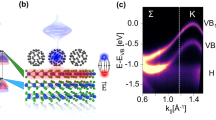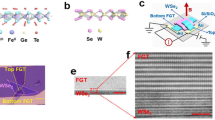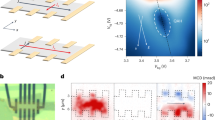Abstract
Material systems that exhibit tunable spin-selective conductivity are key components of spintronic technologies. Here, we demonstrate a mechanism for spin-selective transport that is based on the unusual Landau-level sequence observed in bilayer WSe2 under large applied magnetic fields. We find that the conductivity depends strongly on the relative ordering between conducting electrons with different spins and valleys in a partially filled Landau level and the localized electrons of lower-energy filled Landau levels. We observe that the conductivity is almost completely suppressed when the spin ratio and field-tuned Coulomb energy exceed a critical threshold. We achieve switching between on and off states through either modulation of the external magnetic or electric fields, with many-body interactions driving a collective switching mechanism. In contrast to magnetoresistive heterostructures, this mechanism achieves electrically tunable spin filtering within a single material, driven by the interaction between free and localized spins residing in energy-separated spin-and-valley-polarized bands. Similar spin-selective conductivity may be realizable in flat-band systems at zero magnetic field.
This is a preview of subscription content, access via your institution
Access options
Access Nature and 54 other Nature Portfolio journals
Get Nature+, our best-value online-access subscription
$32.99 / 30 days
cancel any time
Subscribe to this journal
Receive 12 print issues and online access
$259.00 per year
only $21.58 per issue
Buy this article
- Purchase on SpringerLink
- Instant access to full article PDF
Prices may be subject to local taxes which are calculated during checkout




Similar content being viewed by others
Data availability
The data supporting the findings in this study are available via Figshare at https://doi.org/10.6084/m9.figshare.28435061 (ref. 32). Other data are available from the corresponding authors upon reasonable request.
References
Binasch, G., Grünberg, P., Saurenbach, F. & Zinn, W. Enhanced magnetoresistance in layered magnetic structures with antiferromagnetic interlayer exchange. Phys. Rev. B 39, 4828–4830 (1989).
Fert, A. Nobel Lecture: Origin, development, and future of spintronics. Rev. Mod. Phys. 80, 1517–1530 (2008).
Telford, E. J. et al. Layered antiferromagnetism induces large negative magnetoresistance in the van der Waals semiconductor CrSBr. Adv. Mater. 32, 2003240 (2020).
Fert, A. & Campbell, I. A. Two-current conduction in nickel. Phys. Rev. Lett. 21, 1190–1192 (1968).
Chappert, C., Fert, A. & Van Dau, F. N. The emergence of spin electronics in data storage. Nat. Mater. 6, 813–823 (2007).
Vakili, K. et al. Spin-dependent resistivity at transitions between integer quantum Hall states. Phys. Rev. Lett. 94, 176402 (2005).
Falson, J. et al. Even-denominator fractional quantum Hall physics in ZnO. Nat. Phys. 11, 347–351 (2015).
Maryenko, D. et al. Spin-selective electron quantum transport in nonmagnetic MgZnO/ZnO heterostructures. Phys. Rev. Lett. 115, 197601 (2015).
Xiao, D., Liu, G.-B., Feng, W., Xu, X. & Yao, W. Coupled spin and valley physics in monolayers of MoS2 and other group-VI dichalcogenides. Phys. Rev. Lett. 108, 196802 (2012).
Xu, S. et al. Odd-integer quantum Hall states and giant spin susceptibility in p-type few-layer WSe2. Phys. Rev. Lett. 118, 067702 (2017).
Fallahazad, B. et al. Shubnikov–de Haas oscillations of high-mobility holes in monolayer and bilayer WSe2: Landau level degeneracy, effective mass, and negative compressibility. Phys. Rev. Lett. 116, 086601 (2016).
Gustafsson, M. V. et al. Ambipolar Landau levels and strong band-selective carrier interactions in monolayer WSe2. Nat. Mater. 17, 411–415 (2018).
Shi, Q. et al. Odd-and even-denominator fractional quantum Hall states in monolayer WSe2. Nat. Nanotechnol. 15, 569–573 (2020).
Shi, Q. et al. Bilayer WSe2 as a natural platform for interlayer exciton condensates in the strong coupling limit. Nat. Nanotechnol. 17, 577–582 (2021).
Edelberg, D. et al. Approaching the intrinsic limit in transition metal diselenides via point defect control. Nano Lett. 19, 4371–4379 (2019).
Wang, L. et al. One-dimensional electrical contact to a two-dimensional material. Science 342, 614–617 (2013).
Zeng, H. et al. Optical signature of symmetry variations and spin-valley coupling in atomically thin tungsten dichalcogenides. Sci. Rep. 3, 1608 (2013).
Xu, X., Yao, W., Xiao, D. & Heinz, T. F. Spin and pseudospins in layered transition metal dichalcogenides. Nat. Phys. 10, 343–350 (2014).
Pisoni, R. et al. Absence of interlayer tunnel coupling of K-valley electrons in bilayer MoS2. Phys. Rev. Lett. 123, 117702 (2019).
Lin, J. et al. Determining interaction enhanced valley susceptibility in spin-valley-locked MoS2. Nano Lett. 19, 1736–1742 (2019).
Movva, H. C. et al. High-mobility holes in dual-gated WSe2 field-effect transistors. ACS Nano 9, 10402–10410 (2015).
Zeng, Y. et al. High-quality magnetotransport in graphene using the edge-free Corbino geometry. Phys. Rev. Lett. 122, 137701 (2019).
Sodemann, I. & MacDonald, A. H. Landau level mixing and the fractional quantum Hall effect. Phys. Rev. B 87, 245425 (2013).
Peterson, M. R. & Nayak, C. More realistic Hamiltonians for the fractional quantum Hall regime in GaAs and graphene. Phys. Rev. B 87, 245129 (2013).
Simon, S. H. & Rezayi, E. H. Landau level mixing in the perturbative limit. Phys. Rev. B 87, 155426 (2013).
Hunt, B. M. et al. Direct measurement of discrete valley and orbital quantum numbers in bilayer graphene. Nat. Commun. 8, 948 (2017).
Shkolnikov, Y. P., Misra, S., Bishop, N. C., De Poortere, E. P. & Shayegan, M. Observation of quantum Hall ‘valley skyrmions’. Phys. Rev. Lett. 95, 066809 (2005).
Pisoni, R. et al. Interactions and magnetotransport through spin-valley coupled Landau levels in monolayer MoS2. Phys. Rev. Lett. 121, 247701 (2018).
Li, J. et al. Spontaneous valley polarization of interacting carriers in a monolayer semiconductor. Phys. Rev. Lett. 125, 147602 (2020).
Haldane, F. D. M. & Yang, K. Landau level mixing and levitation of extended states in two dimensions. Phys. Rev. Lett. 78, 298 (1997).
Jungwirth, T. & MacDonald, A. H. Resistance spikes and domain wall loops in Ising quantum Hall ferromagnets. Phys. Rev. Lett. 87, 216801 (2001).
Shih, E.-M. et al. Raw data of spin-selective magneto-conductivity in WSe2. Figshare https://doi.org/10.6084/m9.figshare.28435061 (2025).
Acknowledgements
We thank L. Balicas, W. Coniglio and B. Pullum for help with the experiments at the National High Magnetic Field Lab and also thank L. Balicas for helpful discussions. This research is primarily supported by the US Department of Energy (Grant No. DE-SC0016703). The synthesis of WSe2 (D.R. and K.B.) was supported by the Columbia University Materials Science and Engineering Research Center through the National Science Foundation (NSF; Grant Nos. DMR-1420634 and DMR-2011738). The work of K.Y. was supported by the NSF (Grant Nos. DMR-1932796 and DMR-2315954). A portion of this work was performed at the National High Magnetic Field Laboratory, which is supported by the NSF (Cooperative Agreement No. DMR-1644779) and the State of Florida. K.W. and T.T. acknowledge support from the JSPS (KAKENHI Grant Nos. 20H00354, 21H05233 and 23H02052) and the World Premier International Research Center Initiative, MEXT, Japan.
Author information
Authors and Affiliations
Contributions
E.-M.S. fabricated the samples. E.-M.S. and Q.S. performed the transport measurements and analysed the data. D.R., B.K. and J.H. grew the WSe2 crystals. K.W. and T.T. grew the hexagonal BN crystals. K.Y. supervised the theoretical aspects of this work. E.-M.S., Q.S., K.Y., J.H. and C.R.D. wrote the manuscript with input from all the authors.
Corresponding authors
Ethics declarations
Competing interests
The authors declare no competing interests.
Peer review
Peer review information
Nature Physics thanks Jiang-Xiazi Lin and the other, anonymous, reviewer(s) for their contribution to the peer review of this work.
Additional information
Publisher’s note Springer Nature remains neutral with regard to jurisdictional claims in published maps and institutional affiliations.
Supplementary information
Supplementary Information
Supplementary Sections 1–6 including Figs. 1–4 and Table 1.
Rights and permissions
Springer Nature or its licensor (e.g. a society or other partner) holds exclusive rights to this article under a publishing agreement with the author(s) or other rightsholder(s); author self-archiving of the accepted manuscript version of this article is solely governed by the terms of such publishing agreement and applicable law.
About this article
Cite this article
Shih, EM., Shi, Q., Rhodes, D. et al. Spin-selective magneto-conductivity in WSe2. Nat. Phys. 21, 1231–1236 (2025). https://doi.org/10.1038/s41567-025-02918-5
Received:
Accepted:
Published:
Issue date:
DOI: https://doi.org/10.1038/s41567-025-02918-5



